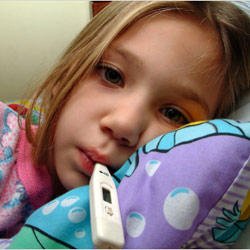Sneezing, coughing and runny noses: Tips to battle the winter bugs

Cold and Flu
The most effective way to decrease complications and reduce the impact of the flu is to give a preventative vaccine shot. The North American vaccine is developed each year to work against three strains of influenza virus, based on trends seen in the Southern Hemisphere. The best time for vaccination is early October to mid-November.
Minor Medical Emergency? Queen Elizabeth Urgent Care Clinic to the rescue
New walk-in clinic helps those seeking urgent care. +
Childhood Immunizations: Get the Facts
If you are the parent of a young child, you may be confused about the safety of immunizations. You may have heard that vaccines cause life-threatening side effects or can lead to other diseases. Or you may have read that vaccines are not necessary anymore. +
Preventing Spread of Infection in Hospital: It is in your Hands
Germs, like virus and bacteria, cause infections. Many of the infections children experience are contagious, such as colds and diarrhea. In hospital, precautionary measures must be taken to limit the spread of infection from one person to another. +
The Do's and Don’t's for Children's Meds
Johnnie or Janie wakes complaining of a headache. You don't want to call your pediatrician at 3 a.m. What do you do? +
Curb Antibiotic Abuse in Children
Your child has a runny nose, a cough, a sore throat and a fever, so you go to the pediatrician. The doctor knows a virus caused this infection, which will just run its course. You're worried, so you push the doctor to give your child an antibiotic. The doctor gives in. +
Children and Runny Noses
Nasal discharge or "runny nose" is a common occurrence among children. It is the result of the excess production of mucus. Although the condition may signal the presence of a cold, a sinus infection or an allergic reaction, it usually does not represent a significant health threat. +
Cough
Coughing is a normal reflex that helps clear the lungs. Usually it is a minor annoyance, but sometimes a cough is a sign of a more serious condition. +
Help for a Child With a Cold
It starts with a sneeze and a runny nose. From your child's symptoms, you suspect you're dealing with a cold. What will you do? +
Fever in Infants and Young Children
A fever is a way for the body to fight infection. But it may also be a sign of a serious illness, especially in children younger than 3 months and children who haven't been immunized. Know when to seek medical care for your child. +
Pneumonia in Children
Pneumonia is a term that means lung infection. It is important for a child with pneumonia to get treatment. But how to know when a cold turns into pneumonia? +
Viral Meningitis in Children
Meningitis is an infection of the membrane and fluid around the brain and spinal cord. Viral meningitis is caused by a viral infection. +
Rheumatic Fever
Rheumatic fever is a serious, delayed complication of streptococcal infections, including strep throat and scarlet fever. It is an inflammation in the connective tissues throughout the body. Connective tissues in the heart, joints and just below the skin are especially susceptible. Although strep throat usually is an acute illness with fever, sore throat and headache, the inflammation resulting from rheumatic fever can cause permanent damage to the heart valves, causing disability or death many years after the acute illness. +
When Your Child Has a Fever
A fever is defined as a temperature above the normal body temperature of 98.6 degrees. Most medical professionals agree that a fever by itself is not an illness; it is a symptom of an underlying problem. Fevers actually can be a positive sign that the body is fighting an infection, because fever stimulates certain defenses, such as white blood cells, which attack and destroy invading bacteria. However, a fever can cause discomfort for a child, increase his need for fluids and make his heart rate and breathing faster. +


